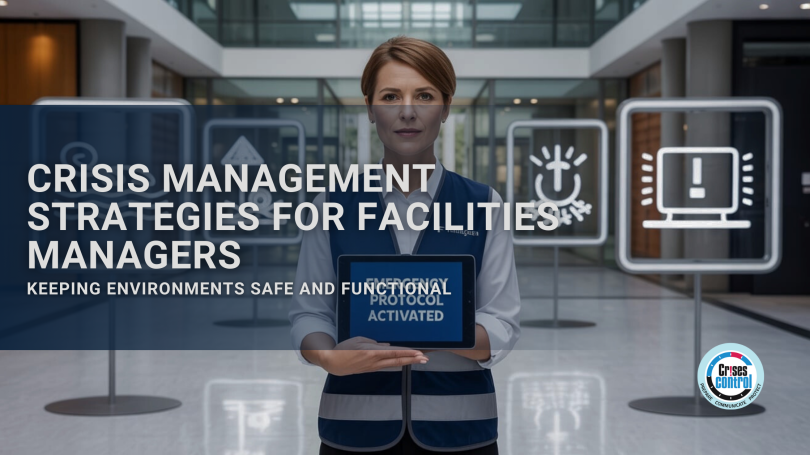Imagine this scenario: you’re a facilities manager overseeing a bustling workplace, everything is running like clockwork, and then, out of the blue, a crisis strikes. Chaos ensues, and suddenly, your well-oiled machine grinds to a halt. This is an all-too-familiar challenge faced by facilities managers worldwide. However, within this challenge lies a significant opportunity. Crisis Management Strategies aren’t just theoretical concepts; they are practical tools to safeguard the continuity and functionality of your facilities. In this blog, you will find insights and actionable steps to help you navigate crises and emerge stronger.
Building Resilience – Crisis Management in Action
Below you’ll find a breakdown of the steps to create a robust business continuity plan, ensuring your facility can weather any storm and keep running smoothly.
- Assess Vulnerabilities: Begin by identifying critical functions and potential vulnerabilities within your facility. What aspects are essential for its everyday operations? What could disrupt them?
- Business Impact Analysis: Evaluate the impact of disruptions. How would they affect your facility’s functionality, employees, and stakeholders? This step helps prioritise what needs protection.
- Develop a Business Continuity Plan: Create a comprehensive plan outlining strategies to maintain operations during a crisis. This includes assigning responsibilities, defining response procedures, and setting up alternate facilities if necessary.
- Regular Testing: A plan is only as good as its execution. Regularly test your continuity plan through drills and simulations to ensure all involved parties are familiar with their roles.
Know Your Enemy – Identifying Business Crises
Understanding your opponent is the first rule of crisis management. In this section, we’ll dissect common business crises, examining what triggers them, how they affect your facility’s operations, and, most importantly, how you can proactively prevent them.
- Natural Disasters: From floods to earthquakes, natural disasters can cripple a facility. Assess your geographical risks and reinforce your facility accordingly. Establish emergency response protocols for each type of disaster.
- Technological Failures: IT outages, equipment breakdowns, and data breaches can halt operations. Implement robust cybersecurity measures, regularly maintain equipment, and back up critical data.
- Human Error: Staff mistakes, accidents, and negligence can lead to crises. Emphasize training, enforce safety protocols, and establish reporting systems to identify and mitigate human error.
- Supply Chain Disruptions: Interruptions in your supply chain can have cascading effects. Diversify suppliers, maintain surplus inventory, and have backup logistics plans in place.
A Step-By-Step Crisis Response Plan
When a crisis unfolds, your response must be swift and well-coordinated. Below, we’ll explore practical steps for crafting a crisis response plan, from assembling your crisis management team to setting up clear communication channels. With these guidelines, you can turn chaos into controlled action.
- Form a Crisis Management Team: Identify key personnel responsible for crisis response. Assign roles and responsibilities, ensuring everyone knows their part.
- Establish Communication Protocols: Clear, efficient communication is paramount during crises. Develop protocols for internal and external communication, including notifying stakeholders, employees, and emergency services.
- Incident Assessment: Gather accurate information about the crisis’s nature and impact. This forms the basis for your response strategy.
- Activate the Crisis Plan: Implement your crisis response plan promptly, adhering to established procedures. Ensure your team knows how to access resources and make critical decisions.
Learning and Adapting – Post-Crisis Analysis Made Easy
After the storm has passed, it’s time to learn from the experience. Discover the importance of post-crisis analysis, and learn how to extract valuable insights that can shape your future Crisis Management Strategies.
- Conduct a Post-Crisis Review: Assemble your crisis management team to review the incident thoroughly. What worked? What didn’t? What could be improved?
- Identify Lessons Learned: Extract actionable lessons from the crisis. These insights will inform updates to your crisis response plan and overall risk management strategy.
Preparation Through Drills and Training
Preparation is the key to success in crisis management. We’ll delve into the significance of crisis drills and training, ensuring that your team not only understands the plan but can execute it seamlessly when the need arises.
- Regular Drills: Practice makes perfect. Conduct crisis drills regularly to keep your team sharp and familiar with their roles.
- Ongoing Training: Invest in ongoing crisis management training for all staff. Equip them with the skills and knowledge needed to respond effectively.
Harnessing Technology for Efficiency
In today’s fast-changing world, Crisis Management Platforms are indispensable for safeguarding lives and business continuity. Here’s why they matter:
- Swift and Informed Decisions: Centralised information and real-time updates enable quick, informed decision-making during crises. Every minute saved can be critical.
- Efficient Coordination: Unified communication hubs streamline interactions among response teams, enhancing coordination and response times.
- Resource Optimisation: These platforms help allocate resources effectively, ensuring they reach where needed most urgently.
- Data-Driven Improvement: Analytics enable post-crisis analysis, allowing organisations to learn from past incidents and continuously improve their response strategies.
- Proactive Preparedness: Crisis planning, simulations, and vulnerability identification enhance preparedness, reducing risks and increasing overall resilience.
In summary, Crisis Management Platforms, like Crises Control, are not just technological investments; they are lifesaving tools that protect assets and maintain business continuity. Their role in promoting swift decisions, efficient coordination, resource optimisation, data-driven improvement, and proactive preparedness is indispensable in today’s unpredictable world.
Conclusion
In our journey through crisis management strategies for facilities managers, we’ve offered practical steps and actionable insights to empower you in the face of crises. Now, you possess the tools to navigate turbulent waters and emerge stronger and more resilient.
Are you ready to turn challenges into opportunities? To witness the strength that crisis management strategies can infuse into your facility’s operations? Request a live demo from Crises Control today. Step into a future where crises are met with confidence, and functionality remains unwavering.







